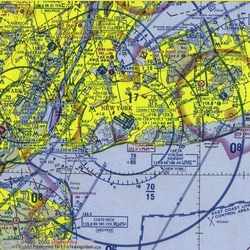Says NextGen Tech Will Help Increase Capacity And Safety
 A new study by the
Reason Foundation states New York's John F. Kennedy International
Airport could reduce delays and increase capacity by adding a new
runway between two existing runways. The group adds even with the
new runway -- which the Foundation says could safely be built
between runways 4R and 4L -- JFK would still have runway spacing
that is greater than the current separation between runways at San
Francisco International Airport, and similar to Boston’s
Logan International.
A new study by the
Reason Foundation states New York's John F. Kennedy International
Airport could reduce delays and increase capacity by adding a new
runway between two existing runways. The group adds even with the
new runway -- which the Foundation says could safely be built
between runways 4R and 4L -- JFK would still have runway spacing
that is greater than the current separation between runways at San
Francisco International Airport, and similar to Boston’s
Logan International.
"Paving down the middle, basically adding another runway between
two existing JFK runways, would do wonders to cut New York’s
travel delays," said Robert Poole, director of transportation
studies at Reason Foundation. "We have the technology to do this
and it is time to implement it. Current runway spacing requirements
stem from obsolete 20th-century technology. New technologies based
on GPS, along with advanced cockpit displays, will make it safe to
operate closely spaced parallel runways, even in reduced visibility
conditions."
But the solution, the Foundation adds, isn't just in new
runways. The report also highlights numerous technological
improvements expected to be implemented as part of the Federal
Aviation Administration's oft-touted NextGen efforts, which Reason
Foundation says will completely revamp the nation’s air
traffic control system over the next two decades.
Full implementation of some of these new systems would increase
runway throughput at JFK by 50 percent and by as much as 45 percent
at Newark Liberty International. Reduced spacing on approaches
would also permit an additional 10 percent throughput on
LaGuardia’s runways.
One of these technologies, Required Navigation Performance, uses
global positioning systems and flight management computers to
program routes that allow planes to make very precise turns and
altitude adjustments, even under poor visibility and bad weather
conditions. Full implementation of Required Navigation Performance
would increase runway throughput at San Francisco International
Airport by more than 50 percent, according to the Foundation.
 Poole -- who has been
an advisor to four US Presidents -- says with so much attention
focused on temporary solutions to today’s debilitating air
travel delays, the long-term capacity problems at the
nation’s major airports are being ignored.
Poole -- who has been
an advisor to four US Presidents -- says with so much attention
focused on temporary solutions to today’s debilitating air
travel delays, the long-term capacity problems at the
nation’s major airports are being ignored.
Air travel is expected to increase 64 percent between 2005 and
2020. By 2015, US airports are expected to handle one billion
passengers a year. And by 2025, eight of the country’s
largest metro areas – Atlanta, Las Vegas, Los Angeles, New
York, Philadelphia, Phoenix, San Diego, and San Francisco –
will need more airport capacity than their current runways can
provide, with current technology and procedures.
The Reason Foundation study reveals a number of ways to expand
capacity at the existing airports in these cities without
increasing their physical size, thereby avoiding costly and
prolonged battles over condemning land and mitigating noise
impacts. The report also details how the NextGen air traffic system
can increase arrival and departure rates, reduce weather delays,
and decrease noise and environmental impacts.
"It’s important for large major metro areas to start
planning to expand their airport capacities based on what these new
technologies will permit, looking forward rather than backward,"
said Viggo Butler, former president of Lockheed Air Terminal and
author of the Reason Foundation report. "That will allow regions to
reap the economic benefits that come with continued growth in air
service without the protracted battles over land acquisition and
environmental impacts that would occur if the airports could only
expand capacity by adding large amounts of land area."
 1st Annual Affordable Flying Exposition Gets Its Footing
1st Annual Affordable Flying Exposition Gets Its Footing Aero-News: Quote of the Day (11.04.25)
Aero-News: Quote of the Day (11.04.25) Aero-News: Quote of the Day (11.05.25)
Aero-News: Quote of the Day (11.05.25) Airborne 10.30.25: Earhart Search, SpaceX Speed Limit, Welcome Back, Xyla!
Airborne 10.30.25: Earhart Search, SpaceX Speed Limit, Welcome Back, Xyla! ANN's Daily Aero-Linx (11.05.25)
ANN's Daily Aero-Linx (11.05.25)




